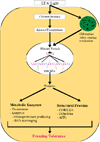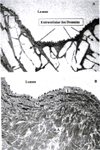BIOPRESERVATION: HEAT/MASS TRANSFER CHALLENGES AND BIOCHEMICAL/GENETIC ADAPTATIONS IN BIOLOGICAL SYSTEMS
- PMID: 24833890
- PMCID: PMC4019075
- DOI: 10.1615/HeatTransRes.2012006187
BIOPRESERVATION: HEAT/MASS TRANSFER CHALLENGES AND BIOCHEMICAL/GENETIC ADAPTATIONS IN BIOLOGICAL SYSTEMS
Abstract
Biopreservation is the science of extending the shelf life (storage time) of biological systems. The scientific field of biopreservation can be broadly classified into three distinct but interrelated research areas: Cryopreservation (storage by freezing), Desiccation (storage by drying) and Freeze-Drying (storage by freezing first and then sublimating the frozen water). Although, both freeze-frying and desiccation create products that are easier to store and transport, they have not, as yet, been successfully applied to store a variety of biological specimens. However, both these technologies have been quite successfully applied in a variety of fields including pharmaceutical sciences and food industry, as demonstrated by the easy availability of shelf-stable drugs and instant mashed potatoes! On the other hand freezing storage has a long and storied history of being used to transport biological specimen, over long distances, as far back as the time of the Pharaohs. However, the lack of portable refrigeration/freezing techniques (and the inviolate second law) limited the use of cryopreservation in every-day life, until the early 19th century. This short review will outline some of the challenges and opportunities in the fields of engineering, heat and mass transfer, biochemical and genetic adaptations in the preservation of biological systems.
Figures





Similar articles
-
New Approaches to Cryopreservation of Cells, Tissues, and Organs.Transfus Med Hemother. 2019 Jun;46(3):197-215. doi: 10.1159/000499453. Epub 2019 Jun 4. Transfus Med Hemother. 2019. PMID: 31244588 Free PMC article. Review.
-
Freeze-drying: A relevant unit operation in the manufacture of foods, nutritional products, and pharmaceuticals.Adv Food Nutr Res. 2020;93:1-58. doi: 10.1016/bs.afnr.2020.04.001. Epub 2020 May 4. Adv Food Nutr Res. 2020. PMID: 32711860
-
Biopreservation of hepatocytes: current concepts on hypothermic preservation, cryopreservation, and vitrification.Cryo Letters. 2013 Jul-Aug;34(4):432-52. Cryo Letters. 2013. PMID: 23995411 Review.
-
Fundamentals of freeze-drying.Pharm Biotechnol. 2002;14:281-360. doi: 10.1007/978-1-4615-0549-5_6. Pharm Biotechnol. 2002. PMID: 12189727 Review.
-
Protein purification process engineering. Freeze drying: A practical overview.Bioprocess Technol. 1994;18:317-67. Bioprocess Technol. 1994. PMID: 7764173 Review.
References
-
- Amann RP, Pickett BW. Principal of cryopreservation and a review of cryopreservation of stallion spermatozoa. J Equine Vet Sci. 1987;7:145–173.
-
- Anchordoguy TJ, Rudolph AS, Carpenter JF, Crowe JH. Modes of interaction of cryoprotectants with membrane phospholipids during freezing. Cryobiology. 1987;24:324–331. - PubMed
-
- Antikainen M, Griffith M. Antifreeze protein accumulation in freezing-tolerance cereals. Physiol. Plant. 1997;99:423–432.
-
- Atlung T, Ingmer H. H-NS: a modulator of environmentally regulated gene expression. Mol. Microbiol. 1997;24:7–17. - PubMed
Grants and funding
LinkOut - more resources
Full Text Sources
Other Literature Sources
